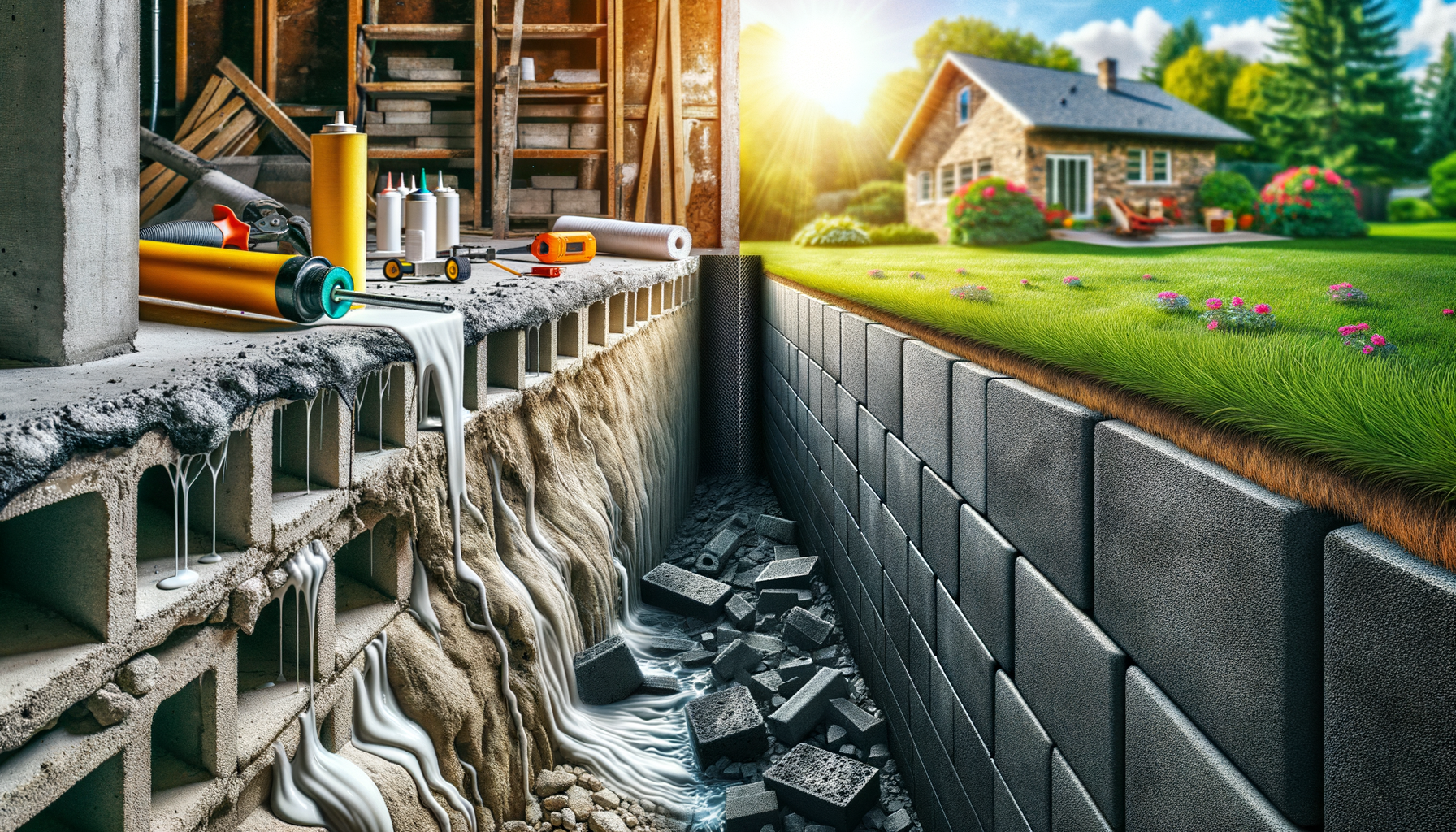What is a Block Foundation?
Understanding Block Foundations
-
Definition and Structure
- A block foundation is made from concrete blocks, usually 8 inches by 16 inches. These blocks are stacked in a zigzag pattern with a sticky paste called mortar holding them together.
-
Common Materials Used
- Concrete Blocks: Most common for block foundations.
- Cinder Blocks: Lighter and often used in older buildings but not as strong as concrete blocks.
Common Uses
-
Typical in Older Homes
- Many homes built before the 1970s have block foundations. You can still see this type of foundation in many older homes in Canada.
-
Popular in Certain Areas of Canada
- Some regions prefer block foundations because they are cheaper and easy to find.
Signs Your Block Foundation Needs Repair
Cracking
-
Horizontal Cracks
- These cracks can mean water pressure problems, suggesting the soil outside is too wet and pushing against the walls.
-
Vertical Cracks
- These cracks may mean the foundation is settling unevenly.
-
Stair-Step Cracks
- These cracks follow the mortar lines in a step-like pattern, showing foundation movement or settling issues.
Leaks and Water Damage
-
Presence of Moisture in the Basement
- Look for damp patches, standing water, or musty smells which could mean water leaks.
-
Efflorescence
- A white powdery residue on walls, left by water that evaporates and leaves behind mineral deposits.
Bowing or Bulging Walls
-
Walls Pushing Inward
- If walls are bowing, it could be because of soil pressure, which is a serious issue.
-
Impact of Soil Pressure
- When soil gets wet, it swells, and when it dries, it shrinks. This movement can push against foundation walls.
Other Signs
-
Floors That Are Not Level
- Sagging or sloping floors may indicate foundation problems.
-
Doors and Windows That Don’t Close Properly
- If doors and windows are misaligned, it may mean the foundation is shifting.
DIY vs Professional Repair
When DIY Might Be Enough
-
Small, Non-Structural Cracks
- Tiny cracks that don’t harm the structure can often be filled with caulking or special sealants.
-
Simple Patching and Sealing
- Minor repairs like patching small cracks or applying waterproof sealant.
When to Call a Professional
-
Major Cracks or Shifting Foundations
- Big cracks or noticeable movement need a professional’s assessment.
-
Signs of Significant Water Damage
- Persistent leaks or water damage need an expert to prevent mold and more problems.
-
Structural Concerns and Safety Issues
- Issues like bowing walls or large shifts in the foundation require professional help.
Common Block Foundation Repair Methods
Crack Injection
-
Materials Used
- Epoxy or polyurethane injections seal cracks and provide structural support.
-
Steps in the Process
- Clean the crack, install injection ports, seal the surface, and inject the material.
Wall Anchors
- Stabilizing Bowing Walls
- Steel anchors are inserted through the wall and attached to the soil outside, providing counter-pressure to keep the wall stable.
- How They Work
- These anchors counteract the soil pressure causing the wall to bow inward.
Carbon Fiber Strips
- Reinforcing Walls
- Carbon fiber strips, bonded with strong adhesives, add strength and prevent further bowing.
Underpinning
-
Methods Like Helical Piers
- Helical piers are screwed deep into stable soil with brackets attached to the foundation for support.
-
When Underpinning is Necessary
- Used when the foundation is settling or shifting too much.
Exterior Solutions
-
Excavation and Waterproofing
- Expose foundation walls, repair cracks from outside, and apply waterproof coatings.
-
French Drains and Other Drainage Systems
- Systems like French drains help direct water away from the foundation.
Costs of Block Foundation Repair
Cost Breakdown
-
Average Cost Ranges for Different Repairs
- Crack injection: $500 to $1,200 per crack.
- Wall anchors: $800 to $1,000 per anchor.
- Carbon fiber strips: $350 to $500 per strip.
- Underpinning: $1,000 to $3,000 per pier.
- Exterior waterproofing: $4,000 to $10,000+ depending on extent.
-
Factors Influencing Costs
- Amount of damage, materials and labor needed, how easy it is to access the area.
Choosing a Contractor
-
Research and Vetting Professionals
- Look for their qualifications, experience, and reviews.
-
Getting Multiple Quotes
- Get quotes from at least three contractors to compare prices.
-
Ensuring Warranty and Insurance Coverage
- Make sure the contractor offers a warranty on their work and proper insurance.
Preventative Measures for Foundation Longevity
Proper Drainage
- Ensuring Downspouts and Gutters Function Properly
- Regularly clean gutters and downspouts to direct water away from the foundation.
Waterproofing Walls
- Exterior and Interior Waterproof Coatings
- Applying waterproof coatings can help keep moisture out.
Landscaping Tips
- Sloping Ground Away from The Foundation
- Make sure the ground slopes away from the foundation by at least 6 inches for the first 10 feet.
Regular Inspections
- Spotting and Addressing Issues Early
- Inspect your foundation yearly to catch and fix issues early.
FAQs about Block Foundation Repair
-
How Long Does Foundation Repair Last?
- Good repairs can last many years, often with warranties from 25 years to the home’s lifetime.
-
Can I Live in My Home During Repairs?
- Most repairs allow you to stay in your home, depending on what needs fixing.
-
Does Homeowner’s Insurance Cover Block Foundation Repairs?
- Insurance usually doesn’t cover settling but may cover sudden issues like water damage if included in the policy.
-
What Causes Foundation Issues in Block Foundations?
- Common causes include water damage, soil pressure, poor construction, and weather conditions.
Resources for Homeowners
Helpful Links
- Articles on Specific Repair Methods
- Canadian Building Codes and Standards
Contact Information for Experts
- Find a reputable foundation repair contractor: Contact Us
This simple guide explains how to spot damage in block foundations, different repair methods, costs, and how to keep your foundation strong. If you notice any issues, getting professional help will keep your home safe for a long time.


Leave a Reply